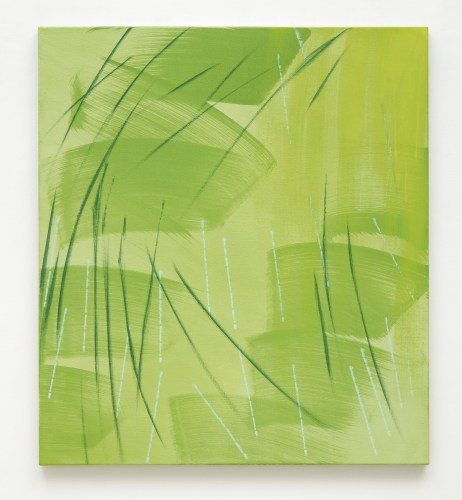
Robert Zandvliet: "Florilegium: Overview 1998 – 2023"
By Robert C. Morgan
March 8, 2024
The artist Robert Zandvliet has been showing his works on paper at the Peter Blum Gallery, together with his paintings, for a reasonable length of time. The current count has presently come to seven—that is, seven exhibitions—during which Zandvliet’s work has made its distinguished gallery appearances on Blum’s walls, welcoming guests galore.
Dutch painting still retains its memories of days at sea, ranging from Rembrandt to the magnitude of exploratory ships that would include Northern paintings given to critical storms moving in all directions. The presence of non-Western influence opened doors to painting’s visionary access. Even so, the link between Dutch art and its miraculous virtuosity became a major aspect in the work of Zandvliet.
In his most recent exhibition, Florilegium: Overview 1998 – 2023, Zandvliet continues his exploration alongside fellow Dutch painters, tracing their journeys primarily along coastal regions. Few artists can boast such a vast body of work, characterized by a meticulous precision, evoking the dense facades of the sea’s whispers.
Zandvliet’s choice of media further enhances the depth of his artistic expression, with works predominantly rendered in egg tempera on linen, complemented by monotypes. This diverse mix of materials reflects his ongoing exploration of technique, with each medium offering unique possibilities for artistic interpretation. The amalgam for Zandvliet has more or less held forth, ultimately coming to terms in which he and his colleague Invar-Torre Hollaus represent positions focused on art history that suggest revisions of a new world beginning.
Central to Zandvliet’s practice is the role of drawing as a mode of conceptual exploration, transcending mere representation to become a conduit for profound artistic inquiry. As it stands, in his view, this is not merely a technical skill but a fundamental aspect of artistic thought, fostering an open dialogue between ideas and perceptions. Robert Zandvliet’s oeuvre embodies a harmonious synthesis of tradition and innovation, inviting viewers to embark on a journey of discovery through the ever-shifting landscapes of his imagination. This is, by far, the most extraneous aspect of a dialogue, possibly the most open-minded relationship of ideas taken from one passage to another.
For the exhibition Florilegium: Overview 1998 – 2023, Zandvliet has divided his evolving exploration of painting into seven “chapters,” each focusing on a specific theme or body of work over the past twenty-five years. Throughout this journey, the landscape emerges as a recurring motif, a constant thread that weaves through his artistic practice. Zandvliet’s approach to landscapes transcends mere naturalism, blending abstract and representational elements reminiscent of Europe’s rich artistic traditions. His works delve beyond surface appearances, seeking to capture the essence of the subjects he portrays and forging a deep connection between artist and object.
The “Chronology” chapter, comprising eighteen works from 2005 to 2023, offers a chronological survey of Zandvliet’s landscape oeuvre. Despite their temporal span, these pieces share various landscape images, all rendered on paper using egg tempera, and are uniformly sized at 9 by 12 1/8 inches. Through this chapter, viewers can trace the artist’s evolving fascination with landscapes, each piece bearing the imprint of his encounters with the natural world, translated into paint upon his return to the studio.
Notably, early works such as Untitled V-10.26.99 (1999), from the “Road Movie” chapter, exhibit pronounced expressive qualities, with monotype-like textures and bold German Expressionist lines. As the chapter progresses, Zandvliet distills fleeting impressions in works like Untitled (2019) and Bumblebee (2020) into abstract forms and vibrant colors, hinting at the fluidity of memory and perception.
The “Heritage” chapter further explores cultural resonances, with pieces like Untitled (2019) evoking Asian landscape paintings, and Strange Stone (2011) paying homage to traditional Chinese garden aesthetics. While Zandvliet’s direct engagement with Eastern artistic traditions may not be explicit, his experimental approach reflects a dialogue between East and West, grounded in the rich tradition of Western landscape painting. The “Moonlit” chapter epitomizes this fusion, with the moon serving as a symbolic beacon imbued with poetic resonance and suggestive depth. Similarly, the “Le Jardin” chapter exudes a joyous vibrancy, capturing the verdant exuberance of a springtime willow tree with simple yet evocative brushwork.
Culminating with the “Signature” chapter, the exhibition encapsulates Zandvliet’s twenty-five-year artistic odyssey, showcasing the convergence of abstract expressionism and emotional depth. This retrospective offers a compelling narrative of Zandvliet’s artistic trajectory, one that resonates with viewers through its exploration of painting as a medium and its celebration of the timeless materials of traditional European artistry, particularly through the medium of tempera.
Zandvliet’s artistic process is marked by an innate awareness of his materials and tools. He frequently uses self-mixed egg tempera to apply thin, fluid strokes onto his canvas, utilizing dynamic brushes and rollers for depth and texture. Recent exploration with oils and acrylics has added further nuance to his compositions. The artist has experimented with all these materials over the past decade in his small-scale, loose works on paper. Zandvliet comments: “Layer upon layer, these little landscapes arise intuitively. With an empty head and color on my brush, I feel free, skating across the paper.” These landscapes have been reduced to an internalized essence, underscoring, looking, and perceiving, that which Zandvliet persistently renews in each chapter of works. Here, the painting belongs together with other paintings that belong together. Maybe this is the moment to acknowledge the title’s deeper meaning whereby the heart of Robert Zandvliet comes alive, ready to pursue the origin of how art begins.